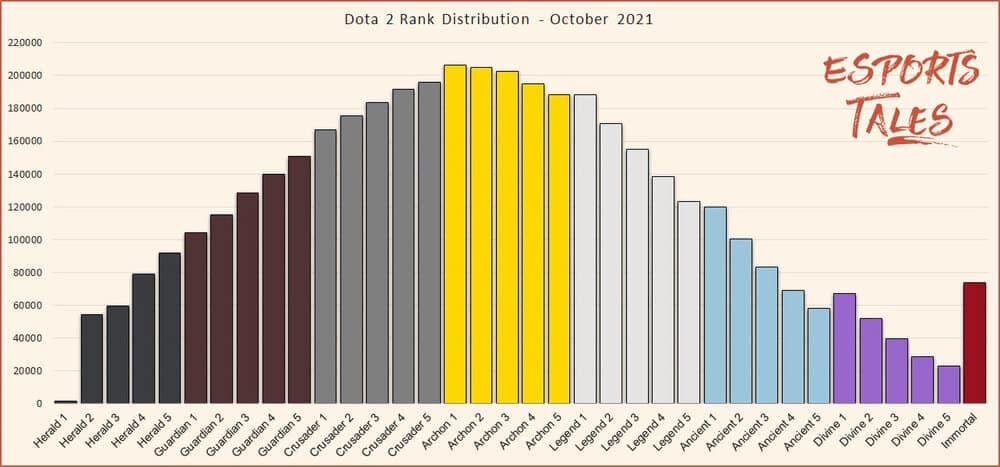Dota 2 ranks explained: Seasonal medals, MMR distribution, & more
 Valve
ValveIf you want to get into ranked play in Dota 2 it can be overwhelming at first, so here’s everything you need to know about the game’s ranks, including MMR distribution, and seasonal medals.
Despite now being over a decade old, Dota 2 still brings in a dedicated fanbase that continues to grow daily. Whether you’re new to the MOBA game or are a seasoned veteran, the ranked mode in Dota 2 can be very confusing at first, especially if you’re unfamiliar with how the competitive system works.
If you’re feeling overwhelmed by the system, we’ve compiled everything you need to know about it in this handy guide, including explaining every rank in Dota 2, exactly how the system works, and how the ranks are designated throughout the player base.
So without further ado, here’s everything you need to know about Dota 2 ranks.
Contents
- How does the ranked system work in Dota 2?
- Dota 2 Ranks
- Dota 2 rank distribution
- Tips and tricks to boost your Dota 2 rank
 Valve
ValveHow does the ranked system work in Dota 2?
Calibration
Dota 2’s ranked mode is only available to players who have played casual game modes such as All Pick and Turbo for more than 100 hours. This is a necessary measure to make sure that new players have familiarized themselves with the fairly difficult mechanics of the game.
After that, you’ll need to play ten calibration games that are determined by a variety of factors. These factors can range from the outcome of these matches to the individual skills and knowledge you display during them.
MMR and Medals
Dota 2 ranks have always been determined by a player’s MMR (matchmaking rating). The premise is simple: you gain or lose MMR based on the result of your ranked matches. Although there used to be a fixed amount of MMR that you could gain or lose after every match, that concept has now been changed with the introduction of Rank Confidence.
Now, you receive or lose MMR based on the average rank of your teammates as well as the opponents. This means, you can find yourself gaining more than 30 MMR after winning against higher-ranked opponents while also earning less than 20 MMR when winning against lower-ranked opponents.
It still works the same way behind the scenes. However, it’s been streamlined over the years to become more in line with the rank tier systems used in other competitive games like League of Legends and Overwatch.
Players receive a medal for each rank and tier they achieve. There are eight ranks in total, each of which is further split into five tiers. The ranks available in Dota 2 are:
- Herald
- Guardian
- Crusader
- Archon
- Legend
- Ancient
- Divine
- Immortal
 Valve
ValveSeasons and re-calibration
It also operates on a seasonal basis, meaning players will need to re-calibrate at the end of every season. Traditionally, this happens every six months. However, the current season has been prevalent for over 17 months now.
The good news, though is that you have the option to re-calibrate by choice once per season. Just don’t expect any drastic differences since re-calibration is based on your existing MMR. It’s unlikely to deviate much. Additionally, with the upcoming release of update 7.31, a new ranked season might be soon upon us.
Dota 2 ranks
Here’s a list of all the Dota 2 ranks and their corresponding medals. We’ve also included a rough estimate of the MMR required for each rank.
| Rank | Medal | MMR |
| Herald 1 |  |
0 |
| Herald 2 |  |
154 |
| Herald 3 |  |
308 |
| Herald 4 |  |
462 |
| Herald 5 |  |
616 |
| Guardian 1 |  |
770 |
| Guardian 2 |  |
924 |
| Guardian 3 |  |
1078 |
| Guardian 4 |  |
1232 |
| Guardian 5 |  |
1386 |
| Crusader 1 |  |
1540 |
| Crusader 2 |  |
1694 |
| Crusader 3 |  |
1848 |
| Crusader 4 |  |
2002 |
| Crusader 5 |  |
2156 |
| Archon 1 |  |
2310 |
| Archon 2 |  |
2464 |
| Archon 3 |  |
2618 |
| Archon 4 |  |
2772 |
| Archon 5 |  |
2926 |
| Legend 1 |  |
3080 |
| Legend 2 |  |
3234 |
| Legend 3 |  |
3388 |
| Legend 4 |  |
3542 |
| Legend 5 |  |
3696 |
| Ancient 1 |  |
3850 |
| Ancient 2 |  |
4004 |
| Ancient 3 |  |
4158 |
| Ancient 4 |  |
4312 |
| Ancient 5 |  |
4466 |
| Divine 1 |  |
4620 |
| Divine 2 |  |
4820 |
| Divine 3 |  |
5020 |
| Divine 4 |  |
5220 |
| Divine 5 |  |
5420 |
| Immortal (Placed) |  |
Regional leaderboard placement |
| Top 1000 (Immortal) |  |
Regional leaderboard placement |
| Top 100 (Immortal) |  |
Regional leaderboard placement |
| Top 10 (Immortal) |  |
Regional leaderboard placement |
| Top 1 (Immortal) |  |
Regional leaderboard placement |
Dota 2 rank distribution
The ranked distribution in Dota 2 is a good way to determine where you stand on a percentile basis relative to other players. According to Esports Tales, Dota 2’s ranked distribution currently looks something like this:

The data suggests that the biggest chunk of Dota 2 players fall between Crusader 1 and Legend 2, and the median rank being Archon 1.
Here’s a table showing the percentile of each rank. You can use it to see where you stack up.
| Rank | Percentile |
| Herald 1 | 0.02 |
| Herald 2 | 0.86 |
| Herald 3 | 1.88 |
| Herald 4 | 3.30 |
| Herald 5 | 5.04 |
| Guardian 1 | 7.04 |
| Guardian 2 | 9.32 |
| Guardian 3 | 11.89 |
| Guardian 4 | 14.76 |
| Guardian 5 | 17.94 |
| Crusader 1 | 21.50 |
| Crusader 2 | 25.32 |
| Crusader 3 | 29.38 |
| Crusader 4 | 33.70 |
| Crusader 5 | 38.19 |
| Archon 1 | 42.99 |
| Archon 2 | 47.87 |
| Archon 3 | 52.73 |
| Archon 4 | 57.53 |
| Archon 5 | 62.19 |
| Legend 1 | 66.92 |
| Legend 2 | 71.25 |
| Legend 3 | 75.25 |
| Legend 4 | 78.83 |
| Legend 5 | 82.02 |
| Ancient 1 | 85.10 |
| Ancient 2 | 87.81 |
| Ancient 3 | 89.85 |
| Ancient 4 | 91.61 |
| Ancient 5 | 93.07 |
| Divine 1 | 94.78 |
| Divine 2 | 96.09 |
| Divine 3 | 97.07 |
| Divine 4 | 97.78 |
| Divine 5 | 98.29 |
| Immortal | 100 |
And that’s everything you need to know about Dota 2’s ranked system.
Knowing all the information is one thing. However, cracking on with the grind is a different beast. But if you put in the work, you’ll be climbing ranks in no time!
Tips and tricks to boost your Dota 2 rank
Dota 2 features one of the highest skill-ceiling available for multiplayer games. This factors into the amount of skill and in-game prowess that players put up on display in their matches. However, there are a few tips and tricks that you can use to ensure a better experience as you grind through the ranked leaderboards. These tips and tricks include:
- Whenever you’re queueing for ranked games, make sure to have the Strict Solo Matchmaking feature activated in your settings.
- It is better to master a few chosen heroes than have a huge hero pool with moderate understanding.
- Make sure to communicate with your teammates about what is happening in the game so that all of you are on the same page.
- Keeping a Positive Mental Attitude (PMA) even when you’re on the verge of losing a match is extremely essential in a MOBA like Dota 2.
- Watching replays of your own matches to understand the errors you made is a very good method of improving your in-game performance.
- The recent addition of the Battle Report in Dota Plus is a wonderful method of keeping a track of your playstyle and recognizing your in-game strengths and weaknesses. This will massively help you improve your performance and climb through the ranked leaderboards.
For more Dota content, check out our guides below:
Dota 2 hero tier list | Dota 2 Diretide 2022 release hub | Best Dota 2 options to optimize game performance | Top 20 highest earning Dota 2 players